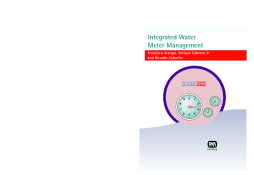
Additional Information
Book Details
Abstract
Water meters are the cornerstone of commercial systems for water utilities throughout the world; revenue is directly derived from the, figures provided by meters. Despite this, little attention has been paid, in terms of selection, replacement period and return on investment, to the management and optimization of water meters.
Integrated Water Meter Management is a comprehensive reference for engineers and managers alike, providing: in-depth technical information allowing the true nature and behaviour of meters to be understood; a comprehensive review and comparison of relevant global water meter technologies - a useful tool to help decide which water meter is best for your utility; discussion of key decisions concerning the use of water meters (when to replace them, which one to use, how to control their quality) from a managerial perspective. Integrated Water Meter Management is an invaluable resource for those involved in urban water management, including water utility managers, engineering technical staff, operations and maintenance specialists, meter-reading personnel and scientific researchers in this discipline.
Table of Contents
| Section Title | Page | Action | Price |
|---|---|---|---|
| Contents | vi | ||
| Preface | x | ||
| Acknowledgements | xi | ||
| About the authors | xii | ||
| 1. Introduction | 1 | ||
| 1.1. Introduction | 1 | ||
| 1.2. An interdisciplinary matter | 2 | ||
| 1.3. Structure of this book | 3 | ||
| 2. Water meters | 4 | ||
| 2.1. Single jet meters | 4 | ||
| 2.2. Multiple jet meters | 17 | ||
| 2.3. Oscillating piston meters | 23 | ||
| 2.4. Nutating disc meters | 30 | ||
| 2.5. Woltmann meters | 33 | ||
| 2.6. Combination (compound) meters | 50 | ||
| 2.7. Paddle wheel meters | 57 | ||
| 2.8. Proportional meters | 62 | ||
| 3. Flow meters | 67 | ||
| 3.1. Ultrasonic flow meters | 67 | ||
| 3.2. Electromagnetic flow meters | 80 | ||
| 3.3. Insertion flow meters | 92 | ||
| 4. Remote meter reading | 103 | ||
| 4.1. Introduction | 103 | ||
| 4.2. Traditional meter reading | 103 | ||
| 4.3. Remote meter reading | 104 | ||
| 4.4. Data handling stages | 106 | ||
| 4.5. Information provided by a remote reading system | 124 | ||
| 5. Integrated water meter management | 126 | ||
| 5.1. Introduction | 126 | ||
| 5.2. Selection of the meter model | 127 | ||
| 5.3. Quality control | 129 | ||
| 5.4. General recommendations for the installation of meters | 131 | ||
| 5.5. Metering systems audits | 132 | ||
| 5.6. Maintenance and renewal of meters in a utility | 134 | ||
| 5.7. Conclusions | 136 | ||
| 6. How accurate are your meters? | 137 | ||
| 6.1. Introduction | 137 | ||
| 6.2. Determining the demand patterns | 139 | ||
| 6.3. Obtaining the error curve | 148 | ||
| 6.4. Calculating how accurate your meters are | 154 | ||
| 6.5. Other methods to assess the weighted error of a meter | 159 | ||
| 6.6. Factors affecting the quality of water consumption measurement | 160 | ||
| 7. Maintenance and renewal of meters in a utility | 175 | ||
| 7.1. Introduction | 175 | ||
| 7.2. Restrictions | 176 | ||
| 7.3. Choosing the right meter | 178 | ||
| 7.4. Economic study | 182 | ||
| 7.5. Case study | 191 | ||
| 7.6. Is it worth going from Class B to Class C? | 193 | ||
| 7.7. Using the commercial information system to analyse the behaviour of meters | 194 | ||
| 8. Meter testing | 203 | ||
| 8.1. Introduction | 203 | ||
| 8.2. Types of test benches | 203 | ||
| 8.3. Test bench layout | 204 | ||
| 8.4. Testing procedures | 211 | ||
| 8.5. Testing for error curve verification on the field | 216 | ||
| 8.6. Uncertainty analysis during tests | 221 | ||
| 8.7. Reference standards | 225 | ||
| 9. Quality control | 226 | ||
| 9.1. Introduction | 226 | ||
| 9.2. Sampling plans | 227 | ||
| 9.3. Definitions | 227 | ||
| 9.4. Description of the quality control procedure | 229 | ||
| 9.5. Application to the reception of meter batches | 232 | ||
| 10. Standards and technical guidelines | 238 | ||
| 10.1. Introduction | 238 | ||
| 10.2. Metrological characteristics | 239 | ||
| 10.3. Technical parameters | 241 | ||
| 10.4. ISO Standards | 243 | ||
| 10.5. Recommendations of the International Organization of Legal Metrology | 250 | ||
| 10.6. Standards from the European Committee for Standardization (CEN) | 252 | ||
| 10.7. American Water Works Association/American National Standard Institute Standards | 254 | ||
| 10.8. European Union Directives | 257 | ||
| Bibliography | 261 | ||
| Index | 265 |
